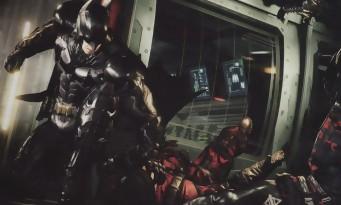 A bit like Mario seems doomed to save Princess Peach who is too stubborn to come to be wary of Bowser (by now she should have equipped herself with a tear gas canister or taken krav-maga lessons), Batman drags himself along his priesthood: save Gotham, thousands of times, inexorably. While by force, we begin to say to ourselves that there must not be much left to save, as this city is so rotten from the inside. At some point, the guy should just let it go and go have a cocktail in a sunny corner. But hey, this brave Bruce Wayne is too good. And therefore too dumb. When the Scarecrow decides to panic everyone by announcing that Gotham has been riddled with bombs containing his famous terror gas, it is still the Black Knight who must step up. But not before a small evacuation of the city; it's the first big string that hurts. Despite a terribly effective and innovative intro, we get stuck on the script of this new Batman from the start. The introduction is rough, as if Rocksteady had wanted to waste a minimum of time developing its setting. No civilians remain in town except the gangsters; hop, so no need to model them or manage them! The Gotham sandbox is yours! And then like that, no mercy to take out the Batmobile after ten minutes of play, at least we are not obliged to pay attention to pedestrians! The problem is that it's a bit of a task and we end up with a taste of deja vu, that of an identical situation in Arkham City and Origins.
A bit like Mario seems doomed to save Princess Peach who is too stubborn to come to be wary of Bowser (by now she should have equipped herself with a tear gas canister or taken krav-maga lessons), Batman drags himself along his priesthood: save Gotham, thousands of times, inexorably. While by force, we begin to say to ourselves that there must not be much left to save, as this city is so rotten from the inside. At some point, the guy should just let it go and go have a cocktail in a sunny corner. But hey, this brave Bruce Wayne is too good. And therefore too dumb. When the Scarecrow decides to panic everyone by announcing that Gotham has been riddled with bombs containing his famous terror gas, it is still the Black Knight who must step up. But not before a small evacuation of the city; it's the first big string that hurts. Despite a terribly effective and innovative intro, we get stuck on the script of this new Batman from the start. The introduction is rough, as if Rocksteady had wanted to waste a minimum of time developing its setting. No civilians remain in town except the gangsters; hop, so no need to model them or manage them! The Gotham sandbox is yours! And then like that, no mercy to take out the Batmobile after ten minutes of play, at least we are not obliged to pay attention to pedestrians! The problem is that it's a bit of a task and we end up with a taste of deja vu, that of an identical situation in Arkham City and Origins.
BRUCE WAYNE, THIS HANDY KID
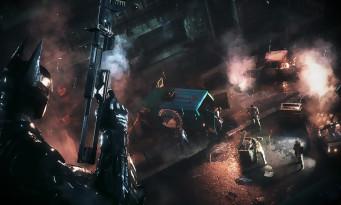 After this first rant (which will not be the last either), it is nevertheless clear that one thing: wooden saber, Arkham Knight is a magnificent game. From the first minutes, this new opus connects the visual potatoes without flinching. The insane viewing distance is the first thing that strikes, though it's aided by the stack of massive, tall buildings that block the view of the horizon; we feel an additional power. Then, we linger on the rain that soaks Gotham, on the textures of Batman's suit, rubber, Kevlar, plastic, metal, all rendered to perfection and on which we could admire the drops running for hours. We chat with NPCs; Face modeling and lip sync are flawless, beyond flawless, with Rocksteady even managing to tone down the inherent shine effect of the Unreal Engine. We sail a little on the roofs of the city: this dear old Gotham is still as gloomy as ever and Rocksteady does wonders when it comes to extracting all the perversion from it to spit it out on the screen, with a sense of surgical detail. . The sense of detail of the artistic direction will also have been a constant in the episodes they will have made and Arkham Knight is no exception to the rule. It's a game completely mastered visually, from A to Z; even the framerate does not make a crease (although here again, we would have to complain given the lack of activity on the screen). And Londoners even succeed in introducing a Batmobile that holds up.
After this first rant (which will not be the last either), it is nevertheless clear that one thing: wooden saber, Arkham Knight is a magnificent game. From the first minutes, this new opus connects the visual potatoes without flinching. The insane viewing distance is the first thing that strikes, though it's aided by the stack of massive, tall buildings that block the view of the horizon; we feel an additional power. Then, we linger on the rain that soaks Gotham, on the textures of Batman's suit, rubber, Kevlar, plastic, metal, all rendered to perfection and on which we could admire the drops running for hours. We chat with NPCs; Face modeling and lip sync are flawless, beyond flawless, with Rocksteady even managing to tone down the inherent shine effect of the Unreal Engine. We sail a little on the roofs of the city: this dear old Gotham is still as gloomy as ever and Rocksteady does wonders when it comes to extracting all the perversion from it to spit it out on the screen, with a sense of surgical detail. . The sense of detail of the artistic direction will also have been a constant in the episodes they will have made and Arkham Knight is no exception to the rule. It's a game completely mastered visually, from A to Z; even the framerate does not make a crease (although here again, we would have to complain given the lack of activity on the screen). And Londoners even succeed in introducing a Batmobile that holds up.
DARK NIGHT : MOST WANTED
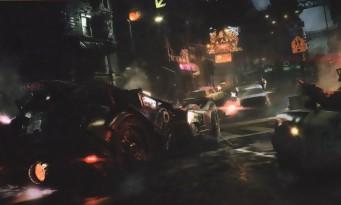 Because yes, you will find yourself at the controls of the racing car in less time than it takes to say "Batou", without even having to deserve it. We then understand that this is not a gadget, and that is part of the problem. But we will come back to that later. First of all, let's salute the work of Rocksteady, which has succeeded where many others have failed in the past, namely designing viable vehicle gameplay in an action/adventure game. I admit I was a little scared to see what it was going to give controller in hand. But in the end, it's a good surprise. Quite similar to a Need For Speed car, the Batmobile is easy to pick up and smooth to drive. It can be called at any time, as long as you are not too far from a rolling terrain, and Batman can eject it when he wishes, to gain speed or throw himself on an enemy for example. The streets of Gotham have been designed wide enough not to impede its progress and anyway, a good part of the obstacles will explode under the power of Bruce Wayne's tank, with an aesthetic close to that of Nolan. The opportunity for the physics engine to offer us lots of nice particle effects that are fun. From all this results an exhilarating feeling of power, especially in chases, during which you must neutralize your opponents with swerves or missile fire. At the same time, the overpowered vehicle of the Dark Knight can also switch to Combat mode, which then transforms it into an ultra-mobile war machine for clashes with the armored vehicles of the Arkham Knight, the enigmatic villain who will replace the Scarecrow. . Fights of another kind, which will put your reflexes to the test and which, if they are a little too recurrent, have the merit of varying the pleasures. Small detail that slams: Batman does not kill, if you try to run over criminals, an electric current will run through the Batmobile at the time of impact to move it away from its path, leaving it more or less unscathed.
Because yes, you will find yourself at the controls of the racing car in less time than it takes to say "Batou", without even having to deserve it. We then understand that this is not a gadget, and that is part of the problem. But we will come back to that later. First of all, let's salute the work of Rocksteady, which has succeeded where many others have failed in the past, namely designing viable vehicle gameplay in an action/adventure game. I admit I was a little scared to see what it was going to give controller in hand. But in the end, it's a good surprise. Quite similar to a Need For Speed car, the Batmobile is easy to pick up and smooth to drive. It can be called at any time, as long as you are not too far from a rolling terrain, and Batman can eject it when he wishes, to gain speed or throw himself on an enemy for example. The streets of Gotham have been designed wide enough not to impede its progress and anyway, a good part of the obstacles will explode under the power of Bruce Wayne's tank, with an aesthetic close to that of Nolan. The opportunity for the physics engine to offer us lots of nice particle effects that are fun. From all this results an exhilarating feeling of power, especially in chases, during which you must neutralize your opponents with swerves or missile fire. At the same time, the overpowered vehicle of the Dark Knight can also switch to Combat mode, which then transforms it into an ultra-mobile war machine for clashes with the armored vehicles of the Arkham Knight, the enigmatic villain who will replace the Scarecrow. . Fights of another kind, which will put your reflexes to the test and which, if they are a little too recurrent, have the merit of varying the pleasures. Small detail that slams: Batman does not kill, if you try to run over criminals, an electric current will run through the Batmobile at the time of impact to move it away from its path, leaving it more or less unscathed.
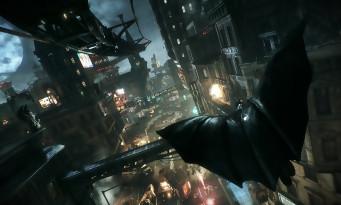 But, as I suggested to you a little higher, the Batmobile is also one of the pitfalls of the game and in more ways than one. We expected a gimmick, a simple means of transportation through Gotham. We were even afraid that was the case. Rocksteady served us the opposite extreme: the studio embedded it almost everywhere, almost all the time, as if it had to justify having created it or more simply make a particularly difficult novelty profitable. In Arkham Knight, the Dark Knight solves almost all his puzzles using his customized vehicle, based on electric winch, walls to explode, "I must bring the Batmobile here to open the door" , remote control, two-level puzzles, etc. The ideas are good but far too used and sometimes introduced in a pinch. To the point of wondering if the Batounet still knows how to do something without his big toy. Even the mystery man, so quick to proclaim that he wants to demonstrate the stupidity of the vigilante, does not stop wanting to confront him on the ground of mechanics (not only by chance). All this seems forced, very unnatural and in the end we hang moderately. On the other hand, the Batmobile is also the symptom of a deeper evil: with this new means of transport, Rocksteady reinforces the simple decor side of Gotham, which we had already felt in the two previous opuses. We don't do anything on foot anymore, all the journeys go at a hundred miles an hour, to hell with contemplation. And yet, the artists in the studio are no less good than in Arkham Asylum; their work is simply much less highlighted, since the player is pushed to move as quickly as possible, without paying a second of attention to what surrounds him. Lots of vagueness, that's what we remember from Gotham.
But, as I suggested to you a little higher, the Batmobile is also one of the pitfalls of the game and in more ways than one. We expected a gimmick, a simple means of transportation through Gotham. We were even afraid that was the case. Rocksteady served us the opposite extreme: the studio embedded it almost everywhere, almost all the time, as if it had to justify having created it or more simply make a particularly difficult novelty profitable. In Arkham Knight, the Dark Knight solves almost all his puzzles using his customized vehicle, based on electric winch, walls to explode, "I must bring the Batmobile here to open the door" , remote control, two-level puzzles, etc. The ideas are good but far too used and sometimes introduced in a pinch. To the point of wondering if the Batounet still knows how to do something without his big toy. Even the mystery man, so quick to proclaim that he wants to demonstrate the stupidity of the vigilante, does not stop wanting to confront him on the ground of mechanics (not only by chance). All this seems forced, very unnatural and in the end we hang moderately. On the other hand, the Batmobile is also the symptom of a deeper evil: with this new means of transport, Rocksteady reinforces the simple decor side of Gotham, which we had already felt in the two previous opuses. We don't do anything on foot anymore, all the journeys go at a hundred miles an hour, to hell with contemplation. And yet, the artists in the studio are no less good than in Arkham Asylum; their work is simply much less highlighted, since the player is pushed to move as quickly as possible, without paying a second of attention to what surrounds him. Lots of vagueness, that's what we remember from Gotham.
THE DISEASE OF THE OPEN-WORLD
 However, this is only the tip of the iceberg. Before the use of the Batmobile, it was the setting up of the sacrosanct open world that slowly but surely gnawed at the Baman Arkham series. Here again, the problem was already specified in dotted lines in the two previous episodes, but it becomes obvious in Arkham Knight: the open-world terribly interferes with the rhythm of the game. When Arkham Asylum took the time to take you, step by step, where the developers wanted it, unrolling little by little the thread of the scenario, gently mounting the pressure, Arkham Knight turns out to be choppy and uneven. The side quests are aptly named and each, without much novelty, is devoted to a type of mission and a big bad guy to put in a cage before the night is over. But it's also a great way to break the rhythm of the adventure, just like the incessant round trips and growing distances. OK, for the first few hours, it's pretty nifty and bad-ass cruising around in the Batmobile or soaring over the city, ever faster and higher thanks to the Dark Knight's new suit. But quickly, we come to get tired of these journeys on a little dull roofs. The unity of time and place, which was the strength of Asylum, which also gave it its claustrophobic side, evaporates, is diluted in the open world. We lose the thread, we look, "What was I already doing? Ah yes, I had to freak out to access the thingy". Writing. Another terrible evil from Arkham Knight. In addition to the always very bland dialogues, the main story, full of unnecessary lengths, lacks a bit of interest, lacks strong moments. Exit the real boss fights for example, with rare exceptions. And we see the final outcome coming several hours in advance.
However, this is only the tip of the iceberg. Before the use of the Batmobile, it was the setting up of the sacrosanct open world that slowly but surely gnawed at the Baman Arkham series. Here again, the problem was already specified in dotted lines in the two previous episodes, but it becomes obvious in Arkham Knight: the open-world terribly interferes with the rhythm of the game. When Arkham Asylum took the time to take you, step by step, where the developers wanted it, unrolling little by little the thread of the scenario, gently mounting the pressure, Arkham Knight turns out to be choppy and uneven. The side quests are aptly named and each, without much novelty, is devoted to a type of mission and a big bad guy to put in a cage before the night is over. But it's also a great way to break the rhythm of the adventure, just like the incessant round trips and growing distances. OK, for the first few hours, it's pretty nifty and bad-ass cruising around in the Batmobile or soaring over the city, ever faster and higher thanks to the Dark Knight's new suit. But quickly, we come to get tired of these journeys on a little dull roofs. The unity of time and place, which was the strength of Asylum, which also gave it its claustrophobic side, evaporates, is diluted in the open world. We lose the thread, we look, "What was I already doing? Ah yes, I had to freak out to access the thingy". Writing. Another terrible evil from Arkham Knight. In addition to the always very bland dialogues, the main story, full of unnecessary lengths, lacks a bit of interest, lacks strong moments. Exit the real boss fights for example, with rare exceptions. And we see the final outcome coming several hours in advance.
Here again, the problem was already clarified in dotted lines in the two previous episodes, but it becomes obvious in Arkham Knight: the open-world terribly harms the rhythm of the game.
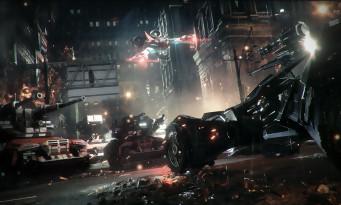 If you have read this far, you have certainly understood that we have some criticisms to make of this new Batman. But it is still part of the top of the pavement and this in particular thanks to a gameplay base that is still as effective as ever. Admittedly, the essentials were already present before, but a few small new features are enough to enhance the whole: a handful of new gadgets, new moves and new eliminations (using surrounding objects or the Batmobile if it is not not far), and voila. The infiltration phases in particular are still enjoyable. On the other hand, the scenario manages some very successful flights, supported by a high quality staging; overall, as soon as Rocksteady stops wanting to ship its story and tries to deviate a little from the beaten path, by digging into the pysché of our superhero, Arkham Knight gains a lot in intensity, and these are the moments that mark the spirits. We would have liked to hear Bruce's thoughts other than to tell us what to do.
If you have read this far, you have certainly understood that we have some criticisms to make of this new Batman. But it is still part of the top of the pavement and this in particular thanks to a gameplay base that is still as effective as ever. Admittedly, the essentials were already present before, but a few small new features are enough to enhance the whole: a handful of new gadgets, new moves and new eliminations (using surrounding objects or the Batmobile if it is not not far), and voila. The infiltration phases in particular are still enjoyable. On the other hand, the scenario manages some very successful flights, supported by a high quality staging; overall, as soon as Rocksteady stops wanting to ship its story and tries to deviate a little from the beaten path, by digging into the pysché of our superhero, Arkham Knight gains a lot in intensity, and these are the moments that mark the spirits. We would have liked to hear Bruce's thoughts other than to tell us what to do.


























